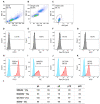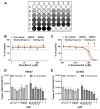The Human Induced Pluripotent Stem Cell Test as an Alternative Method for Embryotoxicity Testing
- PMID: 35328717
- PMCID: PMC8950674
- DOI: 10.3390/ijms23063295
The Human Induced Pluripotent Stem Cell Test as an Alternative Method for Embryotoxicity Testing
Abstract
The evaluation of substances for their potency to induce embryotoxicity is controlled by safety regulations. Test guidelines for reproductive and developmental toxicity rely mainly on animal studies, which make up the majority of animal usage in regulatory toxicology. Therefore, there is an urgent need for alternative in vitro methods to follow the 3R principles. To improve human safety, cell models based on human cells are of great interest to overcome species differences. Here, human induced pluripotent stem cells (hiPSCs) are an ideal cell source as they largely recapitulate embryonic stem cells without bearing ethical concerns and they are able to differentiate into most cell types of the human body. Here, we set up and characterized a fetal bovine serum (FBS)-free hiPSC-based in vitro test method, called the human induced pluripotent stem cell test (hiPS Test), to evaluate the embryotoxic potential of substances. After 10 days in culture, hiPSCs develop into beating cardiomyocytes. As terminal endpoint evaluations, cell viability, qPCR analyses as well as beating frequency and area of beating cardiomyocytes by video analyses are measured. The embryotoxic positive and non-embryotoxic negative controls, 5-Fluorouracil (5-FU) and Penicillin G (PenG), respectively, were correctly assessed in the hiPS Test. More compounds need to be screened in the future for defining the assay's applicability domain, which will inform us of the suitability of the hiPS Test for detecting adverse effects of substances on embryonic development.
Keywords: CardioVision; cardiomyocytes; developmental toxicity; embryotoxicity; hiPS Test; hiPSC; in vitro; video analyses.
Conflict of interest statement
The authors declare no conflict of interest.
Figures









References
-
- Miller B.F., Keane C., O’Toole M.T. Encyclopedia & Dictionary of Medicine, Nursing & Allied Health. 7th ed. W B Saunders Co; Philadelphia, PA, USA: 2003.
-
- MacDorman M.F., Gregory E.C.W. Fetal and Perinatal Mortality: United States, 2013. Natl. Vital Stat. Rep. 2015;64:24. - PubMed
-
- DeSesso J.M. Future of Developmental Toxicity Testing. Curr. Opin. Toxicol. 2017;3:1–5. doi: 10.1016/j.cotox.2017.04.001. - DOI
-
- Weinhold B. Environmental Factors in Birth Defects: What We Need to Know. Environ. Health Perspect. 2009;117:A440–A447. doi: 10.1289/ehp.117-a440. - DOI
MeSH terms
Substances
Grants and funding
LinkOut - more resources
Full Text Sources
Research Materials

